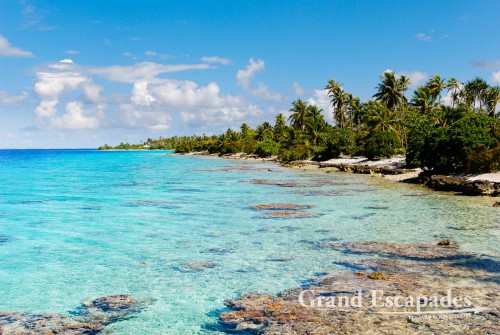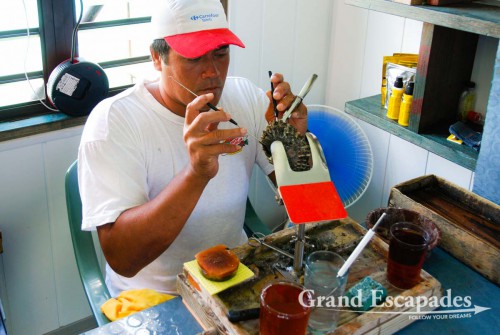Monday morning, the day of our departure from Fakarava, we visited Hinano pearl farm. Black pearls are cultivated throughout French Polynesia and the Cook Islands, the only place in the world, whereas white pearls are traditionally produced in China, Japan and now in Australia as well. It was the Japanese who about 100 years ago developed the technique of cultivating pearls.
The owner of Hinano pearl farm, Herr Günter Hellberg, gave us a brief tour through the production part of his business, which is basically a wooden shack on stilts in the lagoon off his property. This is where nine specialists work, each performing a precisely defined process.
The vital factor that determines the quality of the pearl is the so called “transplant”. It is a tissue taken from an donor oyster, then cut into tiny little pieces and inserted into another oyster together with a so called nucleus. These nucleuses need to be perfectly round and are therefore produced in factories. They look like a pearl but are made of clams specially bred for this purpose.
So you have the person taking out the mantle tissue of a donor oyster and cutting it up, needless to say the oysters dies in that process. The next step is to open the oyster that receives this transplant just a tiny bit, otherwise the oyster would be killed. Then, the “main” specialist inserts the transplant and the nucleus in the tiny opening and closes the oyster. In this process, this specialist may come across an oyster that seems to have the perfect color and thus the right genes. He would then use the tissues of that oyster rather than insert the pearl. Once the oyster is filled and closed, a small hole is drilled into the edge of the oyster and it is tied to large plastic grid. These grids are suspended off shore in the lagoon at 6 to 10 meters below the waterline.
After 1.5 or two years, the first pearls are ready to be harvested. Each oyster is opened only a tiny bit to see if the pearl is of good quality. If this is the case that same oyster is used again, because the transplant has proved to be of high quality, only another nucleus is added. This process can be repeated up to three times.
The five factors that determine the value of a pearl are its shape, perfect surface, size, color and the lustre. A pearl of 14 millimeters, perfectly round and with a flawless surface can sell for as much as 2.000 Euros, but only 2% of all pearls are such top quality. At the shop next to the farm, single pearls or jewelry made of pearls were for sale, somewhere between 10 and 4.000 Euros! But as far as we could udge, Hinano pearl farm seems to have really attractive prices compared to other islands in French Polynesia.
The main customers of Polynesian black pearls are China and Japan: 85% of all pearls are exported to Hong Kong, Shanghai and Kobe. The 15% remaining is sold to the rest of the world. The main producer of Black pearls in French Polynesia is Monsieur Wang, a man of Chinese descent as his name indicates, maybe explaining why the local population claims that “all black pearl business is in Chinese hands”.



No comments yet.